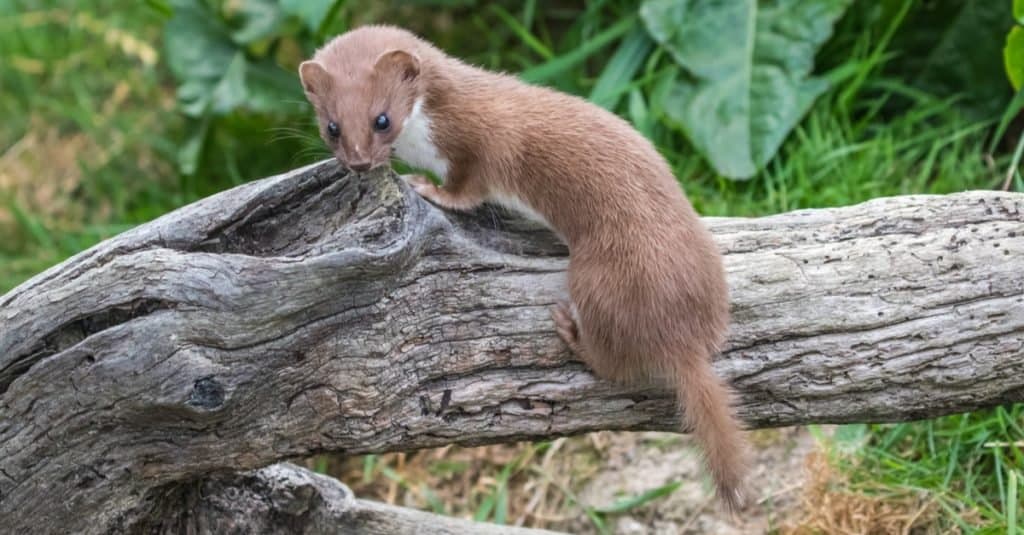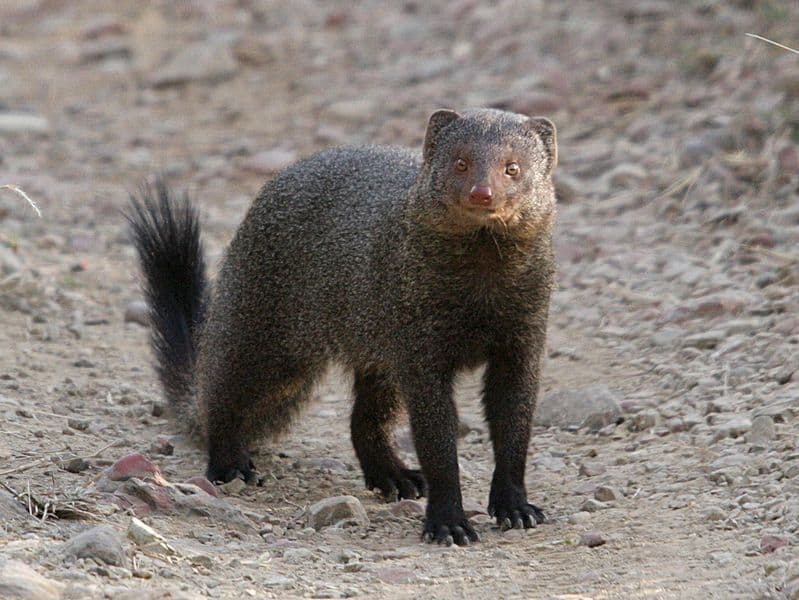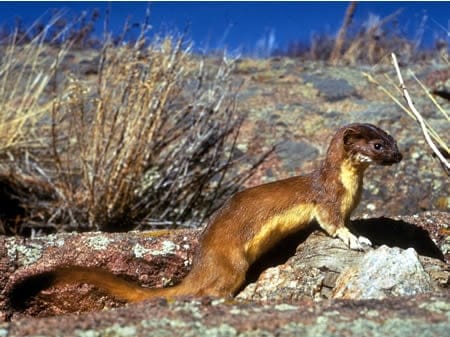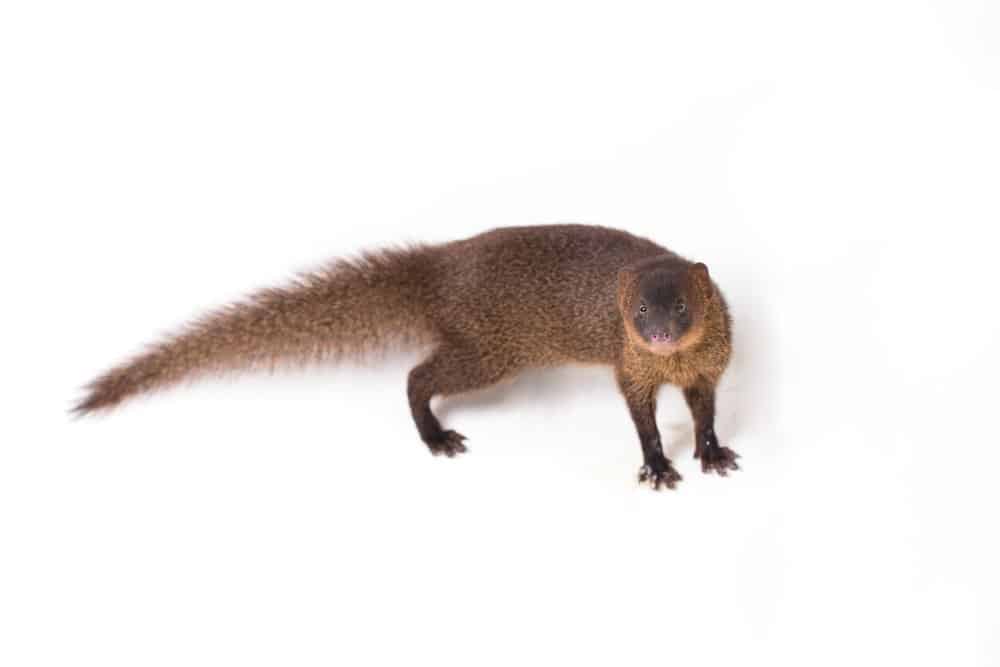
Despite their resemblance to weasels, mongooses belong to the superfamily feliforma, or “cat-like” carnivores, whereas weasels belong to the superfamily caniforma, or “dog-like” carnivores. To help you distinguish between the weasel and the mongoose, we’ve compiled a list of eight major differences!
Weasel vs Mongoose: A Comparison

Weasels are wild creatures that are not easy to live with. Since weasels are carnivores, they have very sharp teeth and claws.
©Stephan Morris/Shutterstock.com
| Key Differences | Weasel | Mongoose |
|---|---|---|
| Size | 10 to 12 in Long / Weight 3 to 12 Ounces / Tails: 4 to 8 in Long | 9.4 to 22.8in Head-To-Body Length, Excluding Tail / 11 Oz to 11 Lb. |
| Colors | Brown on top / White-Yellow under in Summer, White in Winter | Brown or Gray, Some Striped Coats or Ringed Tails |
| Physical Features | Long Slender Bodies; Small, Flattened Heads; Long Necks, Short Limbs | Grizzled Fur: Short-Legs, Pointed Noses, Small Ears; Long Furry Tails |
| Danger | Not Dangerous to people; Will defend using their sharp teeth | Non-Aggressive towards humans; A bite can cause streptococcal sepsis. |
| Diet | Small Mammals like Mice, Voles, Rabbits; Occasionally Birds & Insects | Birds, Small Mammals, Reptiles, Insects, Fruits, Eggs, And Plants |
| Lifespan | 6 to 10 years in the wild | 2-3 Years in the wild; Up to 10 years in captivity |
| Habitats | Open Fields, Woodlands, Thickets, Roadsides And Farmlands | Mostly Terrestrial; Some are semi-aquatic, others are found in treetops |
| Habits | Nocturnal, Spends most time hunting, storing food, and eating | Generally solitary and diurnal, Active early hours, searching for reptiles |
Key Differences Between Weasel vs Mongoose

Mongoose standing alert
Appearance
Weasel vs Mongoose: Size
Weasels are between 10 and 12 inches long and weigh between 3 and 12.3 ounces. Their tails can reach between 4 and 8 inches in length. The length varies from 10.2 and 20.3 cm.
The head-to-body length of a mongoose, excluding the tail, ranges between 9.4 and 22.8 inches. They weigh 11 oz and 11 lb.
Weasel vs Mongoose: Colors
Winter brings white-and-brown weasels; in summer, they’re brown on top and yellow on the bottom. In addition to their grizzled brown or gray coats, most species of mongoose also feature stripes or rings on their tails.
Weasel vs Mongoose: Physical Features
Mongooses have long bushy tails and small ears. They have pointy noses and short legs. This creature’s claws never retract, and each paw has five toes in most cases. The fur is normally grizzled or includes specks of light gray.
Weasels have small, flattened heads with tube-shaped bodies. The necks are long and flexible, and the limbs are short. While the weasel has short, thick hair, its tail is rounded at the tip. Toes end in sharp, curved claws on each foot.
Characteristics

North American Longtail Weasel
©PDH – Public Domain by U.S. National Park Service
Weasel vs Mongoose: Danger
Generally speaking, weasels do not pose a threat to humans, and they generally avoid interacting with humans. However, they will use their teeth to protect themselves from outdoor dogs and cats.
Despite their fascinating reputation for attacking poisonous snakes, mongooses are not aggressive toward humans. Like most wildlife, they may bite humans if they feel threatened or confined. Such wounds have the potential to lead to life-threatening streptococcal sepsis. Life can be saved if the wound is debrided, and broad-spectrum antibiotics are given as soon as possible.
Weasel vs Mongoose: Diet
A mongoose is an opportunistic feeder, eating birds, small animals, reptiles, and insects as well as fruits and vegetables. They consume the eggs and hatchlings of threatened sea turtles and ground-nesting birds. The venom of snakes has little effect on mongooses. Cobras are a common adversary for them, and they are frequently spotted battling with them. Because they know they will not be killed by a snake bite, they are confident enough to even eat the snake afterward.
Food for the long-tailed weasel is meat. Almost 40% of its weight is consumed each day due to its high metabolic rate! Mouse, voles, rabbit, gopher, and chipmunk are its primary food sources. Birds and insects have been known to be eaten by it.
Weasel vs Mongoose: Lifespan
After maturing between 9 months and 2 years, mongooses can survive in the wild for up to 10 years. Weasels can live up to 2–3 years in the wild and 10 years in captivity.
Habitats and Habits

Mongoose (Helogale Parvula) – standing against a white background
©dwi putra stock/Shutterstock.com
Weasel vs Mongoose: Habitat
Weasels inhabit fields, woodlands, thickets, roadsides, and farmlands. They thrive in regions with plenty of tiny prey and water. Weasels live in abandoned burrows, tree nests, or rock piles. Texas, Oklahoma, Kansas, and New Mexico have long-tailed weasels. The northwest, northeast, and Alaska have short-tailed weasels. Great Lakes short-tailed weasels also exist.
Mongooses inhabit most of Africa. Species inhabit southern Asia and the Iberian Peninsula. Some are semi-aquatic treetop mammals. Mongooses live in deserts, tropical woodlands, intricate burrows, or trees. Bushy-tailed mongooses live in lowland river woods. The Gambian mongoose lives in grasslands, scrub, and woodlands.
Weasel vs Mongoose: Habits
Indian gray mongooses are solitary and diurnal, spending most of their time searching for reptiles in the early mornings and early evenings. They are always on the lookout for food, moving at a brisk speed. Even though they can climb trees, they are rarely seen doing so.
Weasels are nocturnal animals known for their ability to sleep during the day and hunt at night. Hunting, storing, and consuming food are the primary activities of a weasel. They can’t store fat in their body, so they must eat all the time to stay energized.
Wrapping Up Weasel vs Mongoose

A close-up of a Borneo Weasel.
In conclusion, weasels and mongooses are distinct mammalian species, with weasels belonging to the Mustela genus and mongooses to a number of other genera. In addition, mongooses and weasels have unique physical traits. Mongooses are cat-like mammals, while weasels are dog-like mammals. Mongooses are not, therefore, related to weasels. However, they are both intriguing creatures to learn about!
The photo featured at the top of this post is © Ghost Bear/Shutterstock.com
Thank you for reading! Have some feedback for us? Contact the AZ Animals editorial team.






